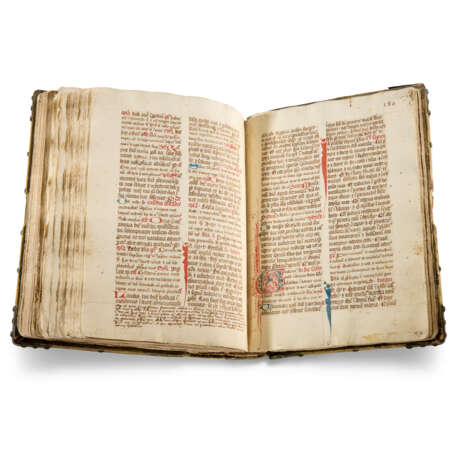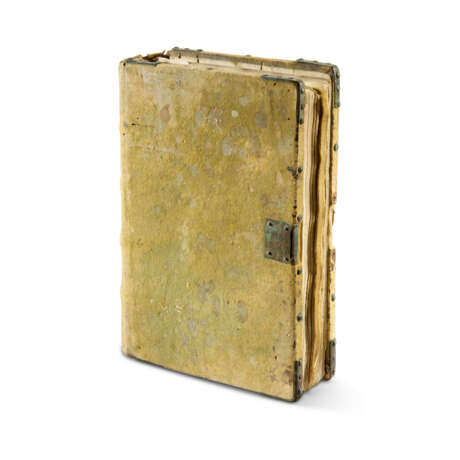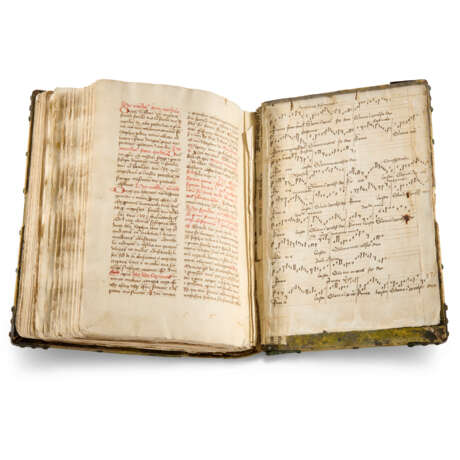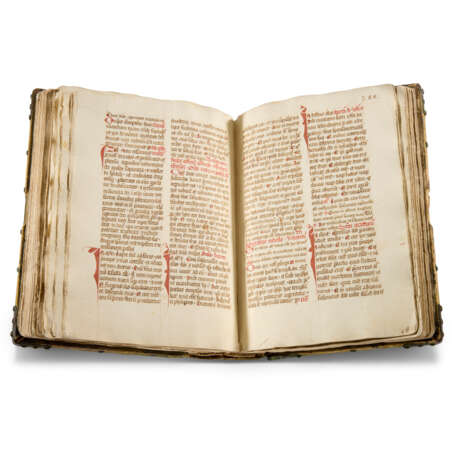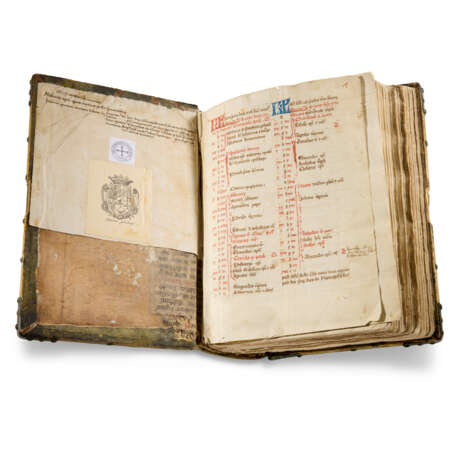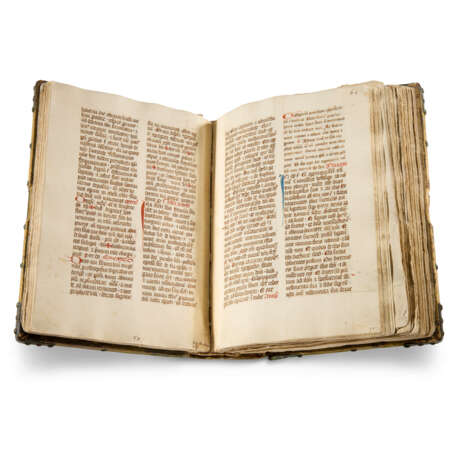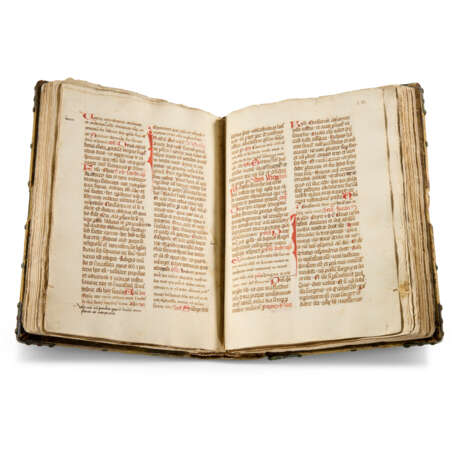ID 1214886
Lot 46 | A Hungarian Missal
Estimate value
£ 12 000 – 18 000
Missal, in Latin, decorated manuscript on paper [Hungary, 15th century]
A Hungarian Missal for use in a parish church, later owned by the Counts von Hardegg, in its contemporary binding.
303 x 210mm. 212 leaves, collation: 13 (of 4, iv a cancelled blank), 29 (of 12, lacking i-iii, i likely a blank, the foliation beginning at 3), 314 (of 12, xiii-xiv inserted singletons), 4-812, 99 (of 12 lacking x-xii, after f.94), 10-1812, 199 (of 12, lacking x-xi, xii the lower pastedown), medieval foliation followed here, beginning after the Calendar and omitting ff.176-77 and 188, two columns of 32 lines, ruled space: 235 x 73mm, catchwords and gathering signatures mostly survive, rubrics in red, occasional music in Esztergom notation, lower pastedown with a Kyrie-Gloria in late Esztergom notation on a 4-line red staff, capitals touched in red, initials in red throughout, a few in blue, some incorporating simple pictures, e.g., a castle on ff.125 and 138v and a fish on f.142v, 11 large initials in 2 colours with decorative penwork, vellum sewing guards from recycled strips of 15th-century documents, one signed by the notary Johannes Rosencrantz, some medieval side-notes, some medieval scraps of paper used as markers and still enclosed between the pages (lacking 13 leaves: ff.1-2, ff.95-97, ff.98-102 with the Canon, and two leaves after f.222, some leaves loose within gatherings, thumbing and soiling, some margins frayed, f.93 partly torn).
Binding:
Contemporary binding of thick wooden boards sewn on 4 double thongs covered with yellow-green reversed leather, metal corner-pieces and studs on edges, lacking clasp but catch present on upper cover, inside spine lining from a piece of a 13th-century liturgical manuscript (a bit battered and scuffed but intact).
Provenance:
(1) The Missal was produced for use in a parish church in Hungary: the Calendar includes in red Sts Ladislas (27June) and Stephen (20 August, instead of 2 September), both described as 'regis hungarie', and St Elizabeth of Hungary (25 November) and adds Emeric, 'ducis hungarie', son of St Stephen, on 4 November. Obits added to the Calendar include Nicholas, son of a ploughman (27 February) and his mother Dorothea (20 December) and a skinner or furrier named Michael ('pellifex', 18 September). Still left between the pages are a number of scraps of 15th-century paper used as markers: one cites Augustine, bishop of Jauriensis (Raab, he was bishop there 1447-65), and another mentions the parish priest Johannes.
(2) Bibliothek Juliusburg: 18th?-century armorial bookplate on inside upper cover with the coat of arms of the Counts of Hardegg. This is the library of the castle at Juliusburg, built in Stetteldorf am Wagram in Austria by Julius II von Hardegg in 1588 and redesigned under Johann Julius IV between 1705-1709. According to the Schoenberg Database the manuscript remained in Germany until 1990, when it was sold at F. Dörling, Hamburg, Wertvolle Bücher, Manuskripte und Autographen, 3-4 December 1990, lot 5.
(3) Sotheby's, 6 December 1993, lot 64.
(4) The Schøyen Collection, MS 1782.
Content:
Calendar ff.i-iii; Temporal from Advent to Holy Saturday ff.3-94v; the Canon of the Mass f.94v; Temporal from Easter to the 25th Sunday after Pentecost ff.103-144v; the Sanctoral from St Andrew (30 November) to St Catherine of Alexandria (25 November), ff.145-194; the Common of Saints ff.194-206; Masses for the dead and other special occasions ff.206-222v.
| Place of origin: | Eastern Europe, Hungary, Europe |
|---|---|
| Auction house category: | Medieval & renaissance manuscripts, Books and manuscripts |
| Place of origin: | Eastern Europe, Hungary, Europe |
|---|---|
| Auction house category: | Medieval & renaissance manuscripts, Books and manuscripts |
| Address of auction |
CHRISTIE'S 8 King Street, St. James's SW1Y 6QT London United Kingdom | |
|---|---|---|
| Preview |
| |
| Phone | +44 (0)20 7839 9060 | |
| Buyer Premium | see on Website | |
| Conditions of purchase | Conditions of purchase |
